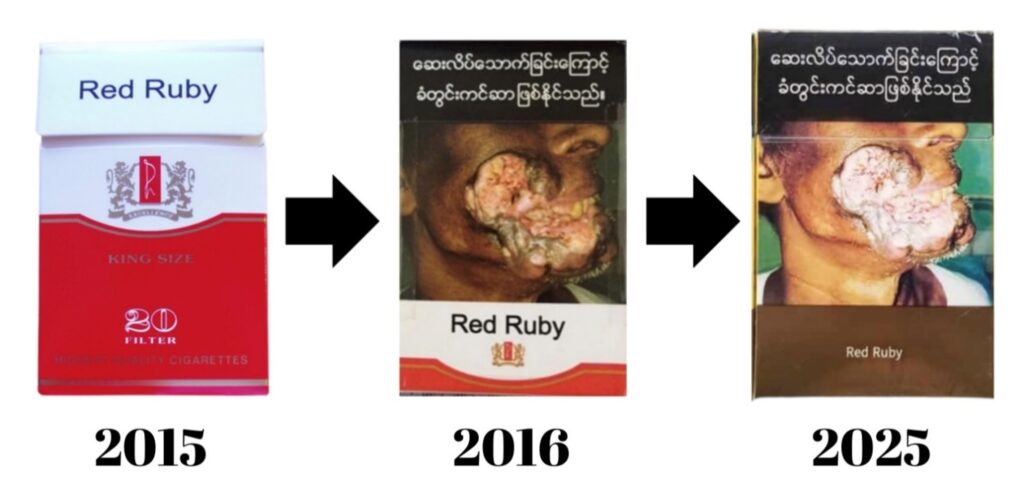Tobacco use poses a severe burden on Myanmar’s health and economy, killing about 64,000 people each year.
Myanmar has marked a significant milestone in protecting public health and advancing global tobacco control efforts with the successful implementation of standardized plain packaging on tobacco products.
First announced in 2021, the regulation faced repeated delays due to interference from the tobacco industry. Tobacco companies attempted to postpone implementation, citing a lack of appropriate equipment, materials and technical capacity to comply with the new packaging requirements. Despite these efforts, Myanmar remained committed to the regulation, which has now taken full effect as of October 2025. Encouragingly, some manufacturers began compliance early, and standardized packs were already visible on the market from September.
“The implementation of standardized plain packaging in Myanmar is a landmark achievement in tobacco control,” said Dr. Tara Singh Bam, Regional Director, Tobacco Control at Vital Strategies Asia Pacific.
“Evidence from countries that have already adopted this measure shows it reduces the appeal of tobacco products, strengthens the impact of health warnings and helps prevent young people from starting to smoke,” continued Dr. Singh Bam.
The policy requires all tobacco products to be sold in a uniform drab brown color (Pantone 448C), with all logos, branding and promotional designs prohibited. Only the brand and variant names are permitted, in a standard font and size, alongside pictorial health warnings covering 75% of principal display areas (50% pictorial and 25% text), plus additional text warnings on side and top panels.

Since 2012, Myanmar has made steady progress toward reducing tobacco use and safeguarding lives. Alongside efforts to create smoke-free environments and shield youth and children from tobacco advertising, the introduction of pictorial health warnings in 2016 marked a major milestone. Before 2016, tobacco packs carried only text warnings, but in February 2016, the Ministry of Health introduced pictorial health warnings covering 75% of the front and back of packs. The Standardized Packaging Notification, issued in October 2021, built on this.
More than half of all adults in Myanmar (54.4%) use some form of tobacco, with 26.1% of adults smoking tobacco (43.8% men and 8.4% women) and 43.2% with smokeless tobacco (62.2% of men and 24.1% of women). Among youth, 30% of boys use some form of tobacco.
In 2016, the economic cost of tobacco was estimated at MMK 2.62 trillion (USD 1.87 billion), equivalent to 3.3% of the country’s GDP. This includes MMK 307 billion (USD 219.3 million) in health care costs and more than MMK 2.3 trillion (USD 1.64 billion) in productivity losses from premature deaths, absenteeism and reduced work performance. The burden falls most heavily on the poor, with 28% of tobacco-related deaths occurring among the lowest income quintile, further deepening poverty and inequality.
“By putting public health ahead of tobacco industry interests, Myanmar has taken a bold and effective step that will save lives and set an example for the region. We applaud this milestone and look forward to its positive impact in the years ahead,” said Dr. Singh Bam.
Since 2012, Vital Strategies has supported Myanmar’s tobacco control efforts through a close partnership with the Ministry of Health. Support has included providing technical assistance, developing and designing policies and programs, building capacity, generating local evidence, promoting the sharing of international best practices, fostering partnerships with national and subnational stakeholders, and strengthening policy implementation. In less than a decade, this partnership has achieved major milestones in tobacco control: the introduction of 100% smoke-free regulations in 2014, the adoption of pictorial health warnings in 2016, the issuance of a code of conduct to prevent tobacco industry interference in 2020, and the adoption of standardized tobacco packaging in 2021.
For more information on Vital Strategies’ work in tobacco control, please visit our Tobacco Control Program page.